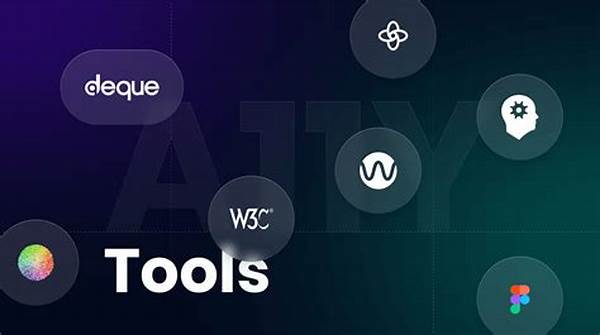In today’s digital age, ensuring that websites are accessible to all users is of paramount importance. This not only includes those with disabilities but also users who rely on different technologies to access the web. For web developers, utilizing accessibility tools is a crucial step in creating inclusive online experiences. These tools help identify potential issues, offer solutions, and ensure that the final product meets global accessibility standards.
Read Now : Digital Music Earnings Transparency
Understanding Accessibility Tools
Accessibility tools for web developers play a significant role in enhancing online experiences for all users. These tools offer invaluable assistance in identifying barriers that might prevent people with disabilities from accessing information or interacting with a website optimally. From checking color contrast for better visibility to providing alternative text for images, accessibility tools are indispensable for creating inclusive web designs. Using these tools, developers are able to simulate different scenarios that a user with visual, auditory, or motor disabilities may encounter, enabling them to make necessary adjustments proactively.
Moreover, many accessibility tools come with features that allow continuous monitoring and immediate feedback on how well a website adheres to accessibility standards. This proactive feedback is invaluable for web developers, helping them ensure that accessibility is not just an afterthought but an integral part of the development process. By integrating these tools into their workflows, developers can significantly enhance the usability of their websites, making them welcoming and functional for everyone, regardless of their abilities.
Essential Accessibility Tools for Web Developers
1. WAVE Web Accessibility Evaluation Tool: This tool helps developers quickly spot and address accessibility issues on their websites.
2. Color Contrast Analyzer: It ensures that text is legible and meets the accessibility standards on any background.
3. Screen Reader Software: Testing with screen readers like NVDA helps in understanding how visually impaired users experience content.
4. Axe Accessibility Checker: An automated testing tool that simplifies the identification of common accessibility issues.
5. Keyboard Navigation Checkers: These tools ensure that web pages are fully functional through keyboard navigation, important for users with motor disabilities.
Challenges in Implementing Accessibility
Implementing accessibility tools for web developers comes with its own challenges. First, the evolving nature of web standards can make it difficult for developers to keep pace with the latest requirements. Different accessibility tools may follow varied guidelines depending on geographic and legal standards, adding a layer of complexity. Moreover, understanding and applying the technical aspects of these tools requires a learning curve which can be daunting for those new to accessibility.
Despite these challenges, the advantages undeniably outweigh the difficulties. Ensuring that websites are accessible not only aligns with ethical considerations but also expands the audience reach significantly. By considering accessibility from the onset of a project, developers can create a seamless user experience, demonstrating their commitment to equality and inclusiveness in digital spaces.
Best Practices for Using Accessibility Tools
1. Integrating tools into the development lifecycle from the beginning ensures that accessibility is maintained throughout the process.
2. Regularly updating the knowledge base regarding accessibility guidelines can prevent non-compliance issues.
3. Collaborating with accessibility experts or advocates can provide insightful feedback on potential improvements.
4. Testing web pages periodically with real users who have disabilities offers practical insights into actual user experiences.
5. Emphasizing education and training for developers ensures they understand the importance and functioning of accessibility tools.
Read Now : Audience-driven Content Innovation
6. Prioritizing user feedback can help identify areas that might need attention which automated tools might miss.
7. Ensuring that all multimedia content has appropriate captions and transcripts can greatly enhance accessibility.
8. Keeping the design simple and user-friendly aids significantly in making websites more accessible.
9. Thorough documentation of the accessibility measures adopted helps in maintaining consistency and quality.
10. Encouraging multidisciplinary collaboration can lead to a more comprehensive accessibility strategy.
The Role of Accessibility in Modern Web Design
Incorporating accessibility tools for web developers fundamentally alters the landscape of modern web design. As the internet becomes increasingly integrated into everyday life, ensuring universal access to digital content has never been more significant. Accessibility tools provide the necessary framework and guidance to build web applications that cater to diverse user needs. However, these tools are most effective when grounded in a genuine commitment to inclusivity. Simply knowing how to use these tools without understanding the underlying principles of accessibility can lead to oversight and misapplication.
Accessibility focuses on designing experiences that are not only usable but engaging for everyone, regardless of their physical, cognitive, or technological abilities. By fostering an inclusive approach, developers unlock the potential to innovate and differentiate themselves in a competitive digital marketplace. Adopting accessibility best practices does more than just comply with legal mandates; it embodies a commitment to user empathy and respect. Furthermore, the insights and innovations driven by accessibility considerations often enhance the overall user experience for everyone, leading to better-designed digital products.
Accessibility in Future Web Development
Looking ahead, the role of accessibility tools for web developers is bound to grow more significant. As technology advances, so too must our approaches to accessibility, ensuring seamless experiences across emerging devices and platforms. Developers who embrace accessibility as a core aspect of their design philosophy will not only keep pace with legal and technological advancements but will also be at the forefront of creating groundbreaking, inclusive digital experiences. This forward-thinking mindset is essential for addressing the ever-evolving needs of users in a diversely abled society.
By focusing on continuous education and leveraging evolving accessibility tools, developers can contribute to a more inclusive internet. A proactive approach to accessibility, coupled with a commitment to understanding diverse perspectives, will ensure that future web development caters not just to the majority but to everyone. This commitment can resonate across the tech industry and foster innovation that empowers users regardless of their capabilities, making the digital world a more equitable and accessible place.
Summary of Accessibility Tools
In conclusion, accessibility tools for web developers are crucial in crafting web experiences that prioritize inclusivity. These tools streamline the process of identifying and rectifying accessibility issues, providing immediate insights into a website’s compliance with accessibility standards. With the help of these tools, developers can create websites that are not only legally compliant but also genuinely welcoming to users of all abilities. As web accessibility gains prominence, developers must remain proactive in adopting these tools.
Employing accessibility tools is a step toward a more inclusive digital ecosystem where every user can interact with web content seamlessly. By consistently updating their skills and understanding accessibility parameters, developers not only improve user experiences but also demonstrate ethical responsibility. As digital technology evolves, so will the demands for accessibility, underscoring the importance of integrating these tools into every stage of web development. Consistently, the application of accessibility tools for web developers is not just about meeting standards, but about championing a more equitable digital future.



